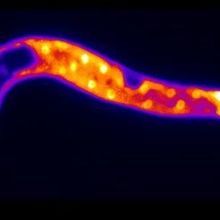Caenorhabditis elegans

Nobel Prize for microRNA
Danielle Gerhard, PhD and Sneha Khedkar | Oct 7, 2024 | 4 min read
Victor Ambros and Gary Ruvkun won this year’s Physiology or Medicine award for the discovery of microRNA and its role in post-transcriptional gene regulation.

Small Model Organisms as Versatile Research Tools
Deanna MacNeil, PhD | Jul 26, 2024 | 5 min read
Flies, worms, and fish with rapid development and characterized genetics help scientists uncover fundamental and universal biological processes, and shape cutting-edge research across disciplines.

A Blueprint for the Ladder of Reproduction
Laura Tran, PhD | Jul 15, 2024 | 1 min read
A trio of proteins are key building blocks for genetic exchange.

Icing Worms to Prolong Memory
Laura Tran, PhD | Jun 18, 2024 | 4 min read
Researchers discovered that chilling worms on ice slows down forgetting, prompting an exploration into the pathway responsible for this cool phenomenon.

Worms Live Longer with Mitochondria Powered by Light: Preprint
Alejandra Manjarrez, PhD | May 24, 2022 | 4 min read
Increasing mitochondrial activity in worms by engineering a light-activated proton pump into the organelle’s membrane extends the animals’ lifespan without evidence of health decline, according to a preprint.

The Science Behind How Roundworms Spit
Diana Kwon | Dec 1, 2021 | 4 min read
By viewing countless hours of expectorating worms, researchers discover a unique way in which neurons control the movement of muscles.

Eyeless C. elegans Perceives Colors: Study
Shawna Williams | Mar 4, 2021 | 4 min read
The roundworm uses cues from visible light to help avoid eating toxic bacteria with a distinguishing hue.

Worm Embryogenesis: Cell by Cell and Gene by Gene
Kerry Grens | Dec 1, 2019 | 2 min read
A single-cell map of C. elegans’s transcriptome during development finds cell lineages that start out genetically different and end up as cells of similar function and genetic profile.

Arsenic-Resistant Nematodes Found in Mono Lake
Abby Olena, PhD | Sep 26, 2019 | 3 min read
Researchers recovered eight species from the salty, alkaline environment—increasing the known biodiversity of animals in the California lake five-fold.

C. elegans Healthier Without Longevity Gene
Chia-Yi Hou | Jul 17, 2019 | 2 min read
Worms with the reproduction-related TCER-1 gene deleted could fight off infection for longer and survived better when exposed to heat and radiation.

Worms’ Magnetic Sense Questioned
Abby Olena, PhD | Apr 25, 2018 | 5 min read
Unsuccessful attempts to reproduce the results of a 2015 study reporting that C. elegans orient themselves by Earth’s magnetic field spark debate among researchers.

Image of the Day: Starved Worm
The Scientist and The Scientist Staff | Nov 14, 2017 | 1 min read
A heat map of gene expression provides insights on the genes that help C. elegans survive severe caloric restriction.

Image of the Day: Better Together
The Scientist and The Scientist Staff | Oct 5, 2017 | 1 min read
When it comes to thwarting roundworms, scientists find that combining four antiparasitic drugs in smaller doses packs a greater punch than the four drugs alone.

A Bacterial Messenger Molecule Extends Healthspan
Sandhya Sekar | Aug 27, 2017 | 3 min read
E. coli that make indoles protect older worms, flies, and mice from frailty.

Study: Eating Less Helps Worms Learn
Aggie Mika | Aug 2, 2017 | 2 min read
Food restriction decreases a metabolite that impedes associative learning in worms.
